Three Dying Trees Bring Together a Community in Detroit

An Interview with The Charles H. Wright Museum of African American History.
In 2018, the Charles H. Wright Museum of African American History discovered three dying Zelkova trees on their campus in Detroit, Michigan. These trees were marked for removal and destined to be mulched for compost. However, in 2019, as part of its mission to be a zero-waste institution, the museum formed a collaboration with the College for Creative Studies (CCS) to instead harvest the timber for creative storytelling. The initial question arose as to how two neighbors – a museum and a college of art & design – can set a precedent for creative practice towards climate action and climate justice in the community?
The Climate Toolkit had the chance to interview the creative forces behind the d.Tree Studio Project and Exhibit.
CLIMATE TOOLKIT:
Thank you so much for convening today. Before we get started, can we go around the circle and give a quick round of introductions?
LESLIE TOM:
Sure. I’m Leslie Tom. I’m the Chief Sustainability Officer at the Charles H. Wright Museum of African American History. I’ve been here for eight years.
ACKEEM SALMON:
My name is Ackeem Salmon. I am the Research and Design Specialist in the Sustainability Department at The Wright Museum. I’m also an alumnus of College for Creative Studies, so I can speak to the duality between both places.
IAN LAMBERT:
I’m Ian Lambert. I’m the Dean of Graduate Studies and Research here at CCS. I’ve been here for about four years. Before that I was in the UK. I started out life as a furniture designer and maker, but fast-forward 30 years and now I specialize in sustainability & design, and design for climate action.
CLIMATE TOOLKIT:
Excellent. Well, it’s great to meet you all. Can we start by giving a general overview of The Wright Museum’s sustainability initiatives and the museum’s commitment to “Making the Invisible Visible”?
LESLIE TOM:
Yes, great question. The Wright Museum started looking into sustainability in 2014 when Wayne State University approached them with a Detroit revitalization fellowship opportunity. At the time our CEO was inspired to bring in a sustainability officer. So long story short, that’s how I got here. My background, I suppose, as an architect and UX user experience designer forced us to pause on how we were defining what sustainability looks like at the museum. When I first got here, we started reducing utilities – we put in variable fan drives, for example, which allowed our motors to not run 24/7 and reduced our energy by $30,000 the first year. But all of that was very invisible because it’s behind the mechanical systems and the walls. We realized that we have an opportunity as a museum to help bring in experiences for people around our environmental world.
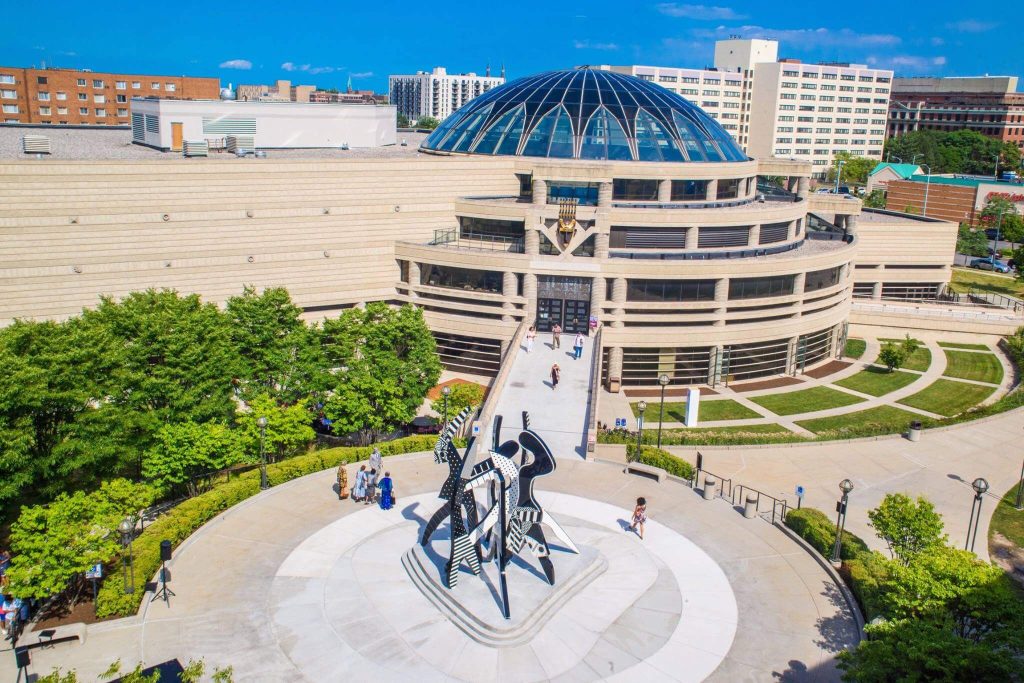
LESLIE TOM:
At the same time, I was also working on installing green stormwater infrastructure – a huge project that now holds 19,000 gallons of stormwater on our site. I worked with community voices, and we were able to build a 70-foot Sankofa, which is an Adinkra symbol representing a bird that shows we can look back to history before we move forward. And just that experience of making these infrastructures a little bit more visible to the public was really satisfying and an opportunity. Our museum Board of Directors and Trustees have now adopted embracing sustainable systems as one of the top goals for the institution. And through that experience, all of our different departments are now able to focus and make the invisible sustainability in our systems a little bit more visible.
CLIMATE TOOLKIT:
It’s so impactful when you receive leadership buy-in at the level where you can actually adopt sustainability as one of the core principles of your museum. So, tell me about the d.Tree Studio Project and how it came into fruition.
IAN LAMBERT:
The Wright Museum had three dying Zelkova trees on their campus. I recalled a project at the Botanical Gardens in Edinburgh where a Wych Elm tree had been felled and given to 25 artists to make what they wanted with it. And they made a variety of very nice artifacts. What could we do, then, when a museum meets an art school with these trees? Was that a different story? And obviously we wanted to elevate a narrative of sustainability – but I think going much deeper than that, given the important mission of the Wright Museum, we had an opportunity to create artifacts that had embedded within them a narrative of social justice and climate justice issues, looking at the African American experience in Detroit.

CLIMATE TOOLKIT:
What did the collaborative and creative process look like between The Wright Museum and the College for Creative Studies?
ACKEEM SALMON:
The collaboration between The Wright Museum and the College for Creative Studies had a profound duality which allowed the context of history and the past and all the aspects of research to create a more metaphorical way of saying: “What did the trees see?” So being able to contextualize, okay, the trees have seen the development of all these generations of people over the years from Anishinaabe tribes to the contextualization to African material culture. And then in the retrospect of looking at design thinking and students. There are two folds to the project of which I was involved. The first component was in 2021 – this was the sanding down portion of getting the course together. The second component was the meditation, which was emphasized through the production of a five-minute film. The meditation became a key component which wove the thread of what exists as design thinking, but also intentional making. And that sense where I was able to work with The Wright Museum – and Leslie specifically – ensuring all these intentionalities of really honoring that question of ‘What did the trees see?’ could coexist with making this art directed storyboard in the context of the City of Detroit. To be honest about that story, as well, and ask: What exactly are the high points of living within the city as well as the low points? And how are we honoring the future?
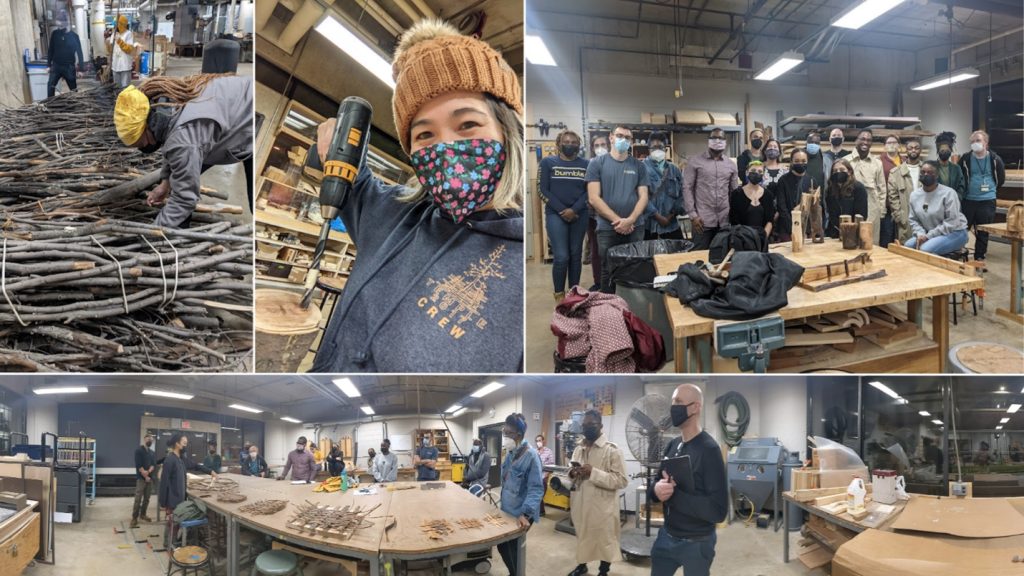
IAN LAMBERT:
We recognized that for the project to be successful, d.Tree couldn’t just be made up of CCS students. To get a more authentic experience of Detroit, we created seven full scholarships for Detroit-based artists and makers to join the class. They either had to come from Detroit, Hamtramck, or Highland Park and have lived in the area for a minimum of three years. And the contribution that these seven scholars made was invaluable to the project because they gave a counterpoint to the CCS students in the class. The 12 students in total worked as a kind of atelier – a creative group where everyone’s pursuing their own individual projects, yet feeding off each other’s ideas, working together with a common aim. And it gave rise to these wonderful objects. In the first instance, the students were experimenting. In the second instance, they were formulating an idea. And in the third instance there was the execution of the project.
ACKEEM SALMON:
What was really beautiful was that the funding which went towards the project was divided between both institutions. We were able to hire students as interns directly from CCS. There were other artists in the city that were hired as well, along with members of The Wright Museum that had their full hand in it. It was a diverse indulgence of knowledge and context. From the meditational process and contextualization to now where we have the exhibition; where we were able to divide funding between institutions and hire these artists locally, hire students to work as interns. Now that I’m formally a part of The Wright Museum, I was able to intentionally use both my experiences to facilitate our students’ needs in design language. This is what we need to contextualize in making sure these five years of research and development and exploration made a whole cohesive story in one room, which is the d.Tree exhibition that we have today. And it was all the hands that went into it, which is the process of collaboration that made it such a successful fruition or opportunity.

IAN LAMBERT:
The project culminated with an exhibition at the Center Gallery in the College, which is in a building that used to be The Wright Museum. Afterwards, we had several gatherings of senior leadership from both the college and the museum. That gave rise to a second exhibition, which is currently on at The Wright Museum, which I think has given us an opportunity to go into a much deeper level of reflection on what we actually achieved. This second exhibition has a production level of a much higher fidelity, and I think the depth of interpretation and the depth of narrative in this exhibition is much richer. Having had a chance to look back and bring in other people, we were able to tell that story in a much more defined way. Leslie and I had already written and published an academic paper which we presented at the Cumulus Conference last year. We’d also gained an international service design award for ‘Impact to Society’ from the International Society of Service Innovation Professionals which we’re very proud of. We’re certainly not the first group of people to take a felled tree and say, let’s turn it into narrative objects. However, I’m not aware of any instance where a museum with a very powerful social history and social justice mission has collaborated with an art school in this way.
CLIMATE TOOLKIT:
You mentioned one of the critical pieces of this project and exhibition was telling the true story of Detroit. Can you talk a little bit for our wider audience about some of the most pressing climate issues the Detroit community is dealing with right now?
LESLIE TOM:
There’s a hard contextual relationship around trees because trees have not been typically taken care of around Detroit. What seemed like a perfect opportunity for The Wright Museum was to collaborate with some of the people that are actually working on tree projects within Detroit. Almost exactly a year ago, the Mayor of Detroit, Mike Duggan, signed a Detroit Tree Equity Partnership with American Forests to plant 75,000 trees, create 300 new jobs, and secure $30 million in investment for Detroit neighborhoods. We’re also working with Michigan State University’s fruit tree initiative to expand urban orcharding in the city. And Greening of Detroit to connect visitors to tree plantings and workforce development programs. Detroit itself has over 1400 urban gardens, which is more than any other city. And then to find our partners like Ian Lambert, developing climate work throughout the College for Creative Studies, working on pulling threads of how to connect climate issues with the public. So, it just seems exciting to have this relationship and partnership both physically with our neighbors and in the space where we’re following some of the City of Detroit’s sustainable Action Agenda initiatives together.
IAN LAMBERT:
I was really struck by the words of Anika Goss – the CEO of Detroit Future City – when she spoke at the Cumulus ‘Design for Adaptation’ Conference back in November last year: “Climate impacts do the most harm in the neighborhoods that are the poorest and the brownest.” It brings up the notion of tree equity. It may seem obvious, but trees create affluence in certain areas. So, if you go into the wealthier areas in Detroit, you’ll see lots of trees; and if you go into the poorer areas, you might see trees as well, but they’re kind of growing out through abandoned houses. There is a correlation between healthy tree canopies and a healthy lifestyle. I think that the connection with trees to equity is super powerful. But equally, Detroit has been cutting down between 10,000 and 20,000 trees a year. Some of these could be small trees, but they are trees, nevertheless. There’s now a tree replanting campaign happening in Detroit, with recognition of the relationship between trees and the health of the city.

CLIMATE TOOLKIT:
It seems like the d.Tree project touches on several aspects of climate sustainability including social justice, diverting waste streams, equity in urban communities, and the contextualization of narratives around climate change. So, this is a two-part question: How can art and museum spaces play a central role in reshaping climate messaging around these subjects? And what kinds of positive climate action do you hope will be inspired from interacting with the d.Tree exhibit?
IAM LAMBERT:
Historically museums have been the pillar of communal narrative, suggesting modes of being or ways of thought. So, especially in the context of climate action and the role the museum plays, it’s bringing these issues at its programmatic forefront where the community is brought within the importance of climate action. For example, doing exhibitions such as these and collaboration at this large scale within these two prominent institutions – it starts to propel the conversation of what the community is doing to take action. As artists, that’s where we can take these more abstract concepts. When we ask the question, ‘What did the tree see?’, it’s poetic, but at the same time is necessary because that is the human aspect of context and climate action. How can we see it more as a human issue versus just this sense of data and systematic thinking that doesn’t move forward with actual human action?
LESLIE TOM:
Our Board of Trustees directed everyone to think about centering Detroit as a leader in the museum field, embracing sustainable systems as some of our strategic goals. Each of the directors, and myself as overseeing sustainability, tried to figure out how we do this. And so, we developed a framework where we’re expanding the triple bottom line to be people, planet, prosperities and programs – because this is what museums do well: learning and engagement, being a third public space. I think this five-year d.Tree project really hit at how to think about including different people and voices throughout the process. So just some fun little data points – we paid over 40 artists as part of what Ackeem was mentioning with the meditation video; we probably brought in over 80 different voices to create listening sessions, making sure we were creating the messages truthfully which sounded right and felt right for Detroiters. Especially for climate because we wanted to make sure that we were messaging the circular economy correctly and the different aspects of what this project encompasses. So yes, being able to work within a museum space and with this group of collaborators really helped to hold truth in a lot of this work.
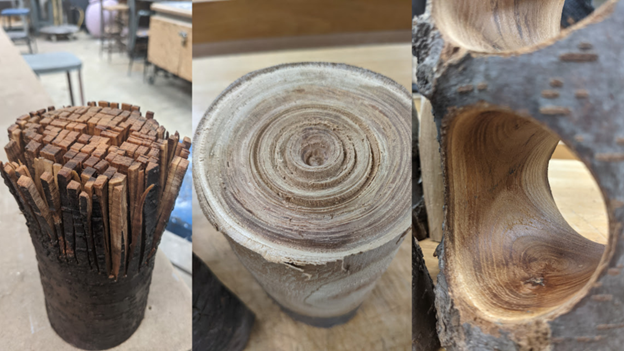
IAN LAMBERT:
Museums are storytelling institutions, and The Wright Museum is an incredibly powerful place to tell stories and be immersed in storytelling. Yet there is a difficulty, I think, in placing the arts or art design’s role in the climate crisis. I’ve had a number of conversations with scientists – and science of course plays an extremely important role in the climate crisis because science helps us understand what’s happening. It gives us a grip of the facts and allows us to know how to respond. Of course, a lot of the responses to the climate crisis are going to be scientific and technological, but the climate crisis is also a cultural crisis, a political crisis, and an economic crisis. I think the role of art and design is to shape culture – shape our material world, shape our visual culture, shape our narrative culture. And sometimes I’ve had these frustrating conversations with climate scientists when I say, oh, we should collaborate. And they say, well, I can’t think what you could possibly design for us. That limited understanding of the scope of what a designer or an artist does. But what I’m trying to say to them is that makers and designers have a different way of seeing problems and a different way of responding to problems that might provide a shift towards some kind of solution. We can try to shift ideas and policies as well, make people change their political approach. It’s extremely complex. There’s no one solution to climate change. It’s not just a simple matter of saying we’re going to stop using oil or we are going to stop burning coal. Those things are important, but that’s not truly the heart of the problem here. It’s all deeply, deeply interconnected.
CLIMATE TOOLKIT:
Thank you all for sharing that. Do you have a sense of the response from the Detroit community surrounding the d.Tree Studio project? Have there been success stories, challenges interacting with the exhibit, or any feedback surrounding this amazing work you’re doing?
LESLIE TOM:
There were many co-benefits that maybe we didn’t even anticipate. For example, one of the museum volunteers, Etta Adams, became our voice of the Detroit trees that everyone mentions from Ackeem’s video. We also brought her in as a voice for our panel discussion for the Tree Symposium that happened with the students in September during their coursework. Part of our thinking was we’re spending quite a bit of money on this class, on these students, but what happens if we were to open the Treeposium up to more people? This was also during Covid. So, we did a virtual tree symposium with CCS’ Design Core as part of the Detroit Month of Design – and over 900 people came out to that. We were able to have the panelists break off into rooms and talk about their experiences with trees and Detroit. And it was just invaluable information for the students to walk away with this deep sense of history. Ackeem created this tagline for the exhibit which sums up the entire experience: “We are respecting the wisdom of people, place, and history as part of this work.”
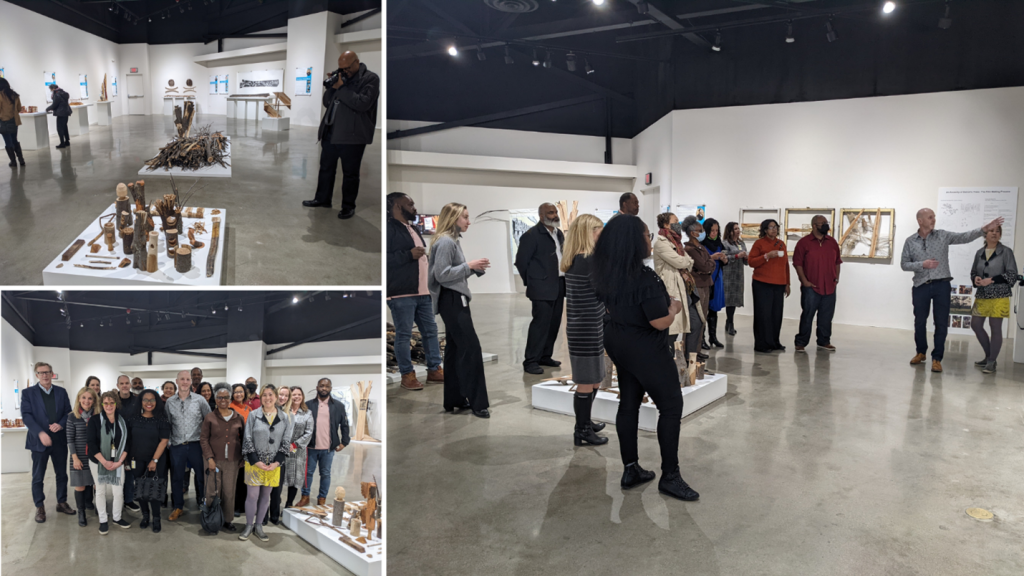
LESLIE TOM:
One other story to share during the CCS exhibit design also involved Etta Adams. Through being involved in the meditation video and the Treeposium, Etta began having conversations with her neighbors – she lives in an elderly housing complex – and told them to come to the Treeposium, watch the video, and started having more and more conversations around trees. As a result, her housing complex started planting more trees and hired a new landscape company to take care of the trees. Ian stood up during the CCS exhibit and was like, we want to bring you and your neighbors to see this exhibit. And so, CCS shuttle vans were coordinated to pick up Etta and her neighbors to come see the d.Tree Project and have an experience at The Wright Museum. And it just became one more moment of like, wow, look at what these three trees have done. Ian came up with this tagline for the project, which is: “Two institutions, three trees, and twelve makers” – just creating a whole palette of experiences and focused culture shifting around trees and expanding awareness of the climate benefits of trees. Additionally, the vision of our Learning and Engagement department at the Wright Museum is to enrich all exhibitions with interpretive programming. I am excited to report that the d.Tree Exhibition inspired a family tree genealogy workshop with Tony Burroughs, renowned genealogist and author of Black Roots: A Beginner’s Guide to Tracing the African American Family Tree. The workshop, d.Tree Genealogy: How to Grow and Sustain Your Family, was shaped by Marline Martin, Director of Learning and Engagement, with over 100 people in attendance.
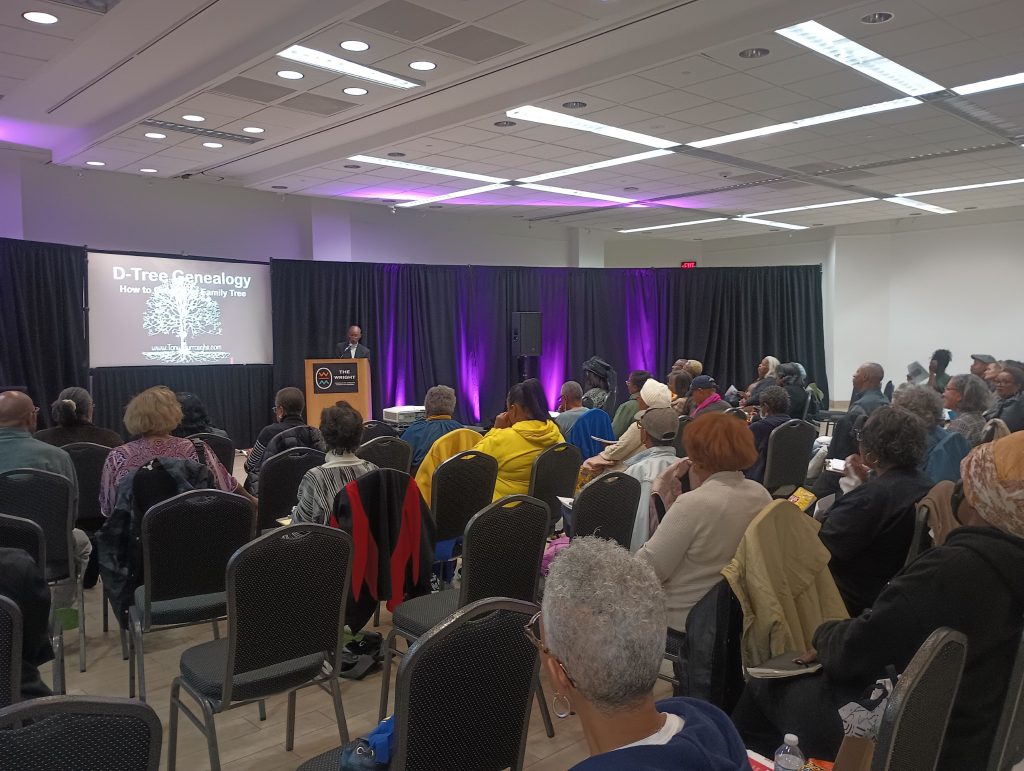
ACKEEM SALMON:
What everyone said is very true in the larger context. I can speak specifically on the artists that were involved, especially being able to hire all these different interns from CCS that I had the pleasure of working with – it was just a different context of working and leadership because each of these students also received real-life leadership positions. Each of them contributed in their own individual rights. So even though I was a studying art director, many of the decisions had to be problem solved by the students and people involved. For example, we hired a motion graphic student from CCS, Sam Pickett, essentially having to walk through the art direction and strategy and then giving her the sensitivity of the project. She started to break down how she would interpret this entire aspect of meditation, the film scoring and all the things that we’ve done into these active texts that will be utilized. And then the same thing goes with the film persons that we brought on board. It felt like each of those artists got an independent opportunity to show themselves without feeling like they’re caught in a box. It just gave them that opportunity to speak up. And that gave rise to collective action. So, on top of the exhibition and the social aspect of the community, the leadership opportunities that were given to younger voices were just exceptional. And I felt that each artist and young participant in it had a light that they were able to shine. And I think that was also a really beautiful component, and outcome of the process.
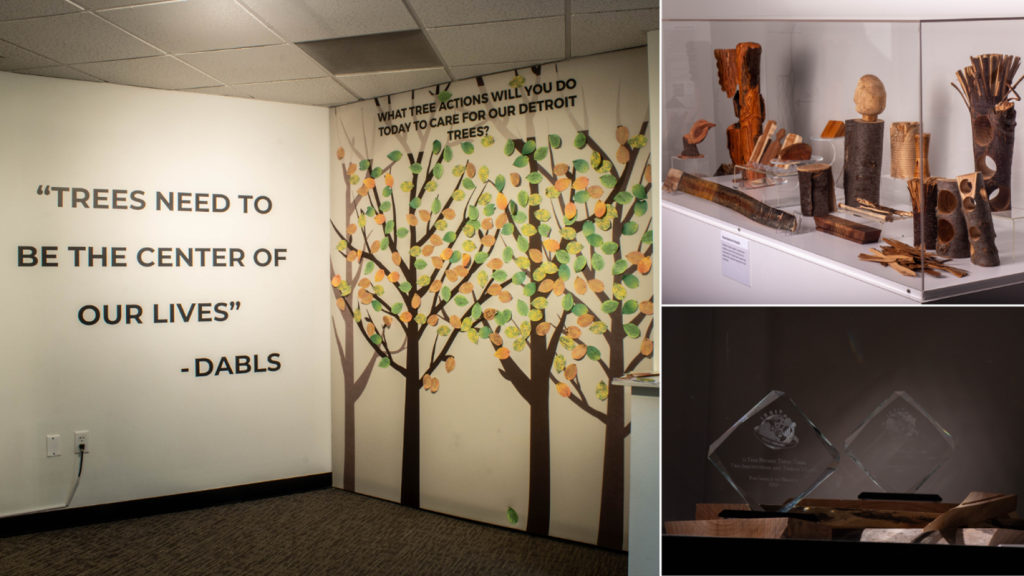
CLIMATE TOOLKIT:
I love how you framed the entire project, three dying trees just bringing the entire community together. I think that’s a really beautiful story. So, my final question of our interview today, and this can be for anybody in the group, do you have any advice or takeaways for other museums or cultural institutions that are hoping to create climate inspired exhibitions or community engagement work?
IAN LAMBERT:
They should hire Leslie.
LESLIE TOM:
(laughter) Well, I do want to plug this one thought. We did measure our carbon footprint for the whole exhibit for The Wright Museum. We worked with Indigo JLD Green + Health and Cambridge Seven to help us do some analysis. And it was incredible to open up that process where our curatorial team and design & fabrication team would basically email all the items that we bought or added to this exhibit, and we would get a carbon number for everything. Ultimately it was around 1.8 tons of carbon that we were using for the d.Tree exhibit. I know the Guggenheim did a similar study – and this is all coming from the Gallery Climate Calculator Guide. The Guggenheim was 10 tons of carbon for a local exhibit. And then there was another London gallery, and that was 100 tons of carbon because some were flying artwork around and commuting by air. As a collective, we just started thinking about how to reduce our carbon footprint. Our director of fabrication, for example, would suggest printing in house so that we didn’t have to use a car to drive prints around. Using fewer toxic materials. Hand-painting the exhibit walls. And so, it’s really leaning into all of us, with this shared foundation of wanting to reduce our carbon footprint, of wanting to divert waste from the landfill, that we are all starting to look at things differently and really uncover the fact that this is a cultural shift. Museums and Art & Design Schools have the opportunity to help shift that culture. And I think this d.Tree project is a very solid example of how we re-looked at every touchpoint within the system. And working with artists, designers on the backend, creatives, humanitarian-minded people within this museum context – we want to be able to share this work with the larger community.
IAN LAMBERT:
The other thing to emphasize is that the project isn’t over. We are thinking actively about what to do next. One of the things that is critical is that we need funding to move forward. We did spend quite a lot of money on this project, although it was definitely worth it. We got a small amount of funding from the Michigan Arts and Culture Council. We are now having to think about going after significant funding. There are grant monies out there that we can apply to, and I think we’ve got such a strong foundation to move forward on. It may help us if you just let people know that we are now looking at opportunities, and contemplating phase two and what that looks like.
CLIMATE TOOLKIT:
I appreciate all of your time and your energies for sharing this beautiful story, and I’m very excited to share this piece with our Climate Toolkit community.
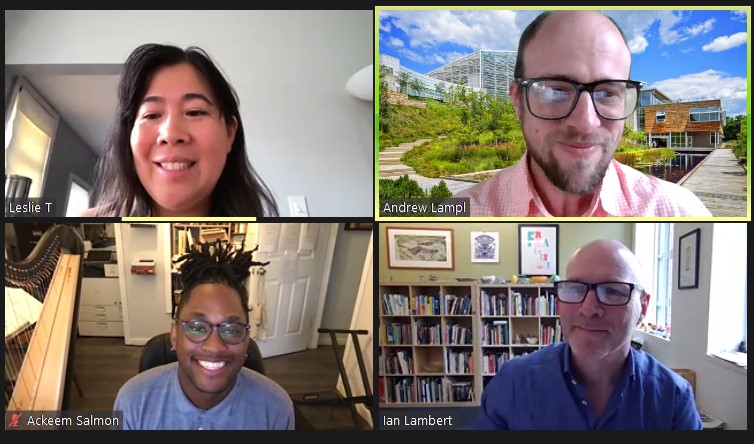
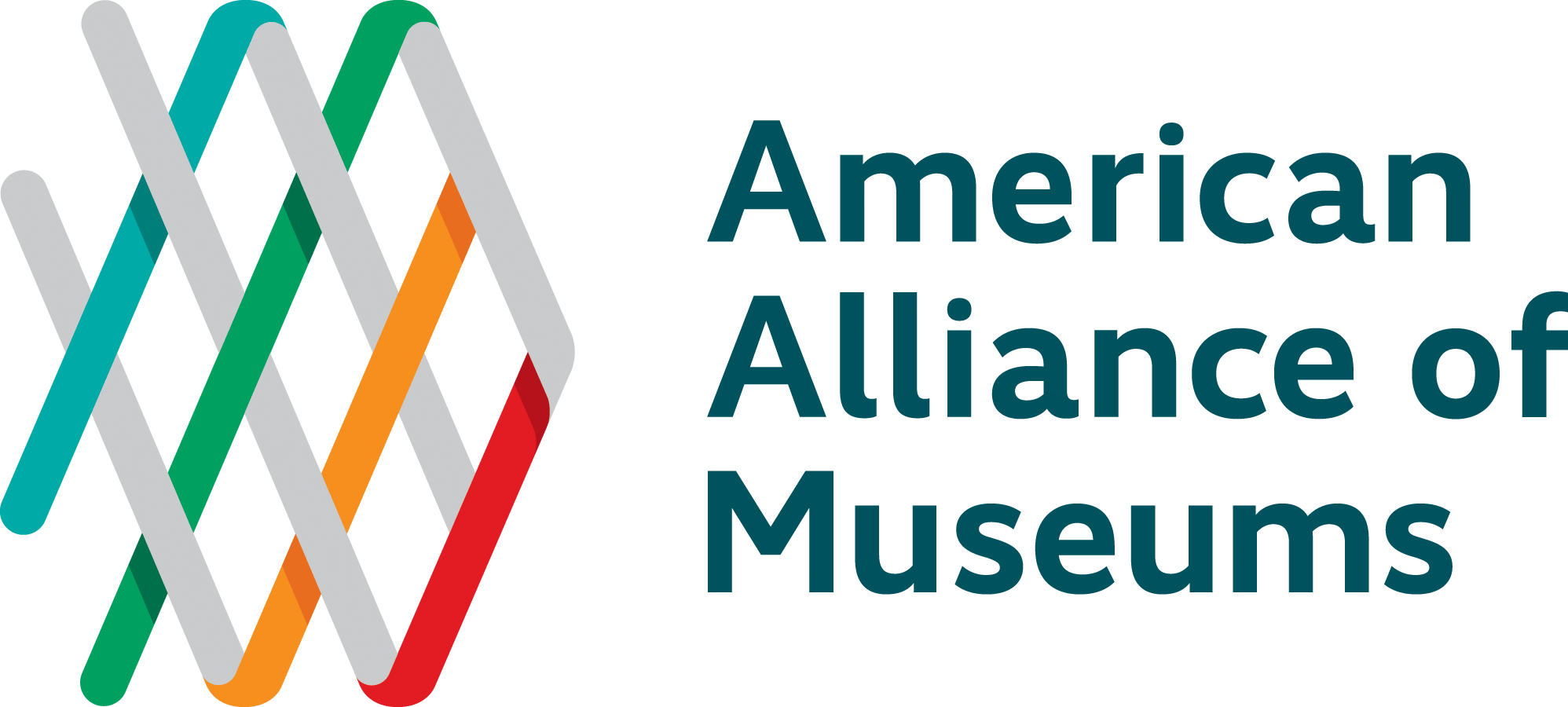

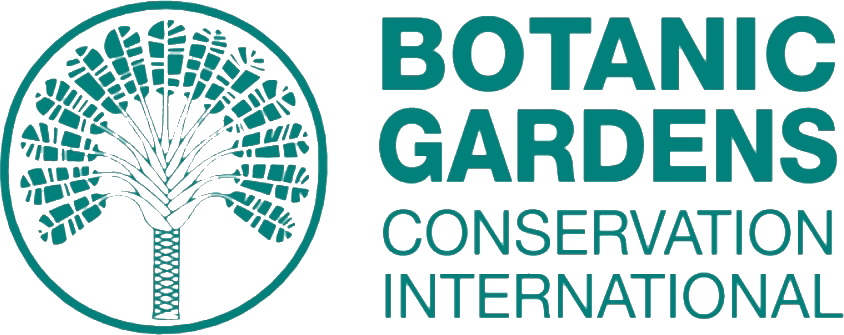



Recent Comments